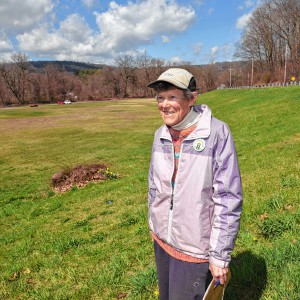Speaking of Nature: The milkweed tussock moth
| Published: 09-14-2020 9:32 AM |
I’ve started my morning commute to work again, and for the past week, I’ve been listening to the daily weather summary on NPR. Covering a wide area of southern New England, this rundown of atmospheric conditions and regional statistics is always very interesting to me. For some reason, I like knowing what is going on at the summit of Mt. Washington and (even stranger) the Canadian research station of Eureka in the Nunavut Territory. Located on Elsmere Island, Eureka is one of the northernmost permanently manned outposts in the world.
Here, far to the south of Eureka, we notice that the days are getting shorter and perhaps even a little cooler. In Eureka, the daily temperatures are already below freezing and it has been snowing. Things are starting to change as Earth makes its reliable way around the sun. The Northern Hemisphere is turning away from the sun and life here is about to change in a profound way. In a month the leaves will start falling, we will have frost and it will be time to say goodbye to the insects for another year.
One of the most fascinating and beautiful things about the natural world is the almost incomprehensible ability of life to survive in conditions that would kill a human in no time. Winter, in particular, is a season that presents challenges that are almost too staggering to really wrap your mind around and this is compounded by the fact that we humans don’t really live “in” the winter. We have invented little bubbles of summer where we spend most of our time; lonely venturing out into winter as we move between our home bubbles, work bubbles and food bubbles.
The rest of the non-migratory animals that live in our area have to find a way to endure winter. The fact that the world is once again filled with animals every spring, is a testament to their durability, but the ways in which they survive often seem stupendously foreign to us. To give you a hint of what I’m speaking of, let’s consider a small, unobtrusive creature known as the milkweed tussock moth (Euchaetes egle).
Chances are that you’ve seen one of these little animals and not known what you were looking at. My Peterson Field Guide to Moths (yes, I’m the guy who owns that book) describes the milkweed tussock moth as being “mouse gray” in color and just a smidge under one inch in length. A member of the tigermoth family, this species is small, triangular and – well – quite unremarkable.
In contrast, the caterpillar of this species is bright, vibrant and quite striking in appearance. A little over an inch in length, this little creature is decorated with black, white and orange “hairs” that help fend off predators. Feeding exclusively on milkweed plants, the milkweed tussock caterpillars appear to find older milkweed plants acceptable, whereas monarch caterpillars tend to favor younger plants with “fresher” leaves.
In the fall, the second generation of adult tussock moths yield to the cold and the continuation of the entire species will depend on the strange abilities of the tussock moth pupae. The little caterpillars will eventually find a safe place where they can encase themselves in silken cocoons and begin the process of transforming from their larval stage (the caterpillar) to their adult stage (the moth). It is in this transitional stage (known as the pupa) that the animal can endure the winter in a sort of suspended animation; sealed up and protected from the elements while it waits for spring.
So the next time you feel a bit chilly and you reach for a blanket in which to wrap yourself, know that you are not alone. You probably purchased the blanket that you will use, but the caterpillar of the milkweed tussock moth will weave its own. Then rejoice in your ability to eat delicious food, talk with friends and fill your time with pleasant distractions during the coming winter. The only time you may actually envy the caterpillar is in the dead of winter when you wish you could just ignore the alarm, pull a blanket over your head and sleep for a month. In that one aspect of life the caterpillar has you beat.
Article continues after...
Yesterday's Most Read Articles
 Greenfield man arrested in New York on murder charge
Greenfield man arrested in New York on murder charge
 Former Leyden police chief Daniel Galvis charged with larceny
Former Leyden police chief Daniel Galvis charged with larceny
 Judge dismisses case against former Buckland police chief
Judge dismisses case against former Buckland police chief
 Greenfield Police Logs: April 9 to April 17, 2024
Greenfield Police Logs: April 9 to April 17, 2024
 Millers Meadow idea would ‘completely transform’ Colrain Street lot in Greenfield
Millers Meadow idea would ‘completely transform’ Colrain Street lot in Greenfield
 Greenfield’s Court Square to remain open year-round for first time since 2021
Greenfield’s Court Square to remain open year-round for first time since 2021
Bill Danielson has been a professional writer and nature photographer for 23 years and only occasionally wishes he could pupate during the winter. He has worked for the National Park Service, the US Forest Service and the Massachusetts State Parks and currently teaches high school biology and physics. Visit www.speakingofnature.com for more information, or head over to Speaking of Nature on Facebook.

 Speaking of Nature: Indulging in eye candy: Finally, after such a long wait, it’s beginning to look like spring is here
Speaking of Nature: Indulging in eye candy: Finally, after such a long wait, it’s beginning to look like spring is here Celebrating ‘Seasonings’: New book by veteran preacher and poet, Allen ‘Mick’ Comstock
Celebrating ‘Seasonings’: New book by veteran preacher and poet, Allen ‘Mick’ Comstock Faith Matters: How to still the muddy waters of overthinking: Clarity, peace and God can be found in the quiet spaces
Faith Matters: How to still the muddy waters of overthinking: Clarity, peace and God can be found in the quiet spaces A time for every purpose under heaven: Free sing-a-long Pete Seeger Fest returns to Ashfield, April 6
A time for every purpose under heaven: Free sing-a-long Pete Seeger Fest returns to Ashfield, April 6
